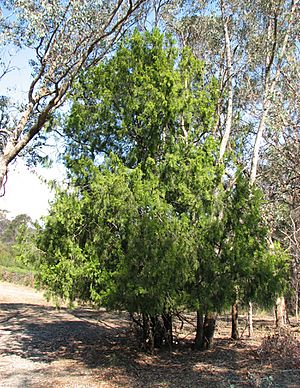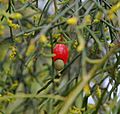Exocarpos cupressiformis facts for kids
Quick facts for kids Exocarpos cupressiformis |
|
|---|---|
 |
|
| Scientific classification | |
| Genus: |
Exocarpos
|
| Species: |
cupressiformis
|
 |
|
| Occurrence data from AVH | |
The Exocarpos cupressiformis, often called native cherry, cherry ballart, or cypress cherry, is a unique plant. It belongs to the sandalwood family. This species is endemic to Australia, meaning it's found nowhere else in the world. Sometimes, its genus name is spelled "Exocarpus," but this spelling is rarely used now.
Contents
What it Looks Like and How it Grows
The cherry ballart looks a lot like a cypress tree. It can be a large shrub or a small tree, growing from 3 to 8 meters (about 10 to 26 feet) tall. It often has a pyramid shape.
When the plant is young, it's a "hemiparasite." This means it gets some of its food and water from the roots of other trees, especially Eucalyptus trees. As it gets older, it relies less on other trees. Its green, drooping stems do most of the work of making food from sunlight (photosynthesis), because its leaves are very small, like tiny scales.
Its flowers are small and hard to see. They grow in clusters on short spikes, only 3–6 millimeters long. Only one flower on each spike will turn into a fruit. The actual fruit is a small, hard, greenish nut, about 4-6mm long, with one seed inside. This nut sits on top of a short stalk, called a pedicel. As the nut grows, this stalk swells up to 5-6mm wide and turns yellow or red. This swollen, colorful stalk is the edible "cherry" part. It doesn't have a hard stone inside like a European cherry.
The name Exocarpos comes from Latin and means "outside fruit." This is because the true, seed-like fruit (the nut) is found on the outside of the fleshy, false "fruit" (the swollen stalk).
Where it Lives
You can find cherry ballart plants in sclerophyll forests. They especially like shallow soils and rocky areas made of granite in eastern Australia. Their habitat stretches from Queensland down to Victoria, from the coast to the inner side of the Great Dividing Range, and also in Tasmania. In South Australia, you can find them in specific forest areas. These include the Mount Lofty Ranges, the Fleurieu Peninsula, Kangaroo Island, parts of the Yorke Peninsula and Eyre Peninsula, and the Mount Remarkable National Park.
Some people have said that the leaves of this plant are harmful to animals. However, official sources don't mention any harm. In fact, pictures show that plant-eating animals do eat its leaves.
How People Use It
Indigenous Australian people used the wood from the cherry ballart for many things. They made spearthrowers and bull roarers from it.
The wood itself is pale and has a very fine grain. It doesn't have much pattern but often has beautiful color changes. In the past, this wood was used to make furniture, gun-stocks, and tool handles. Today, it's also popular for carving and turning. Artists use it to create decorative and ornamental pieces.
The fleshy, swollen stalk, which is the "cherry" part, is edible. Both Indigenous Australians and early European settlers ate it. People would pick the "fruit" when it was very ripe, almost ready to fall off the tree. It could be eaten raw or cooked.
An old book from 1889, called 'The Useful Native Plants of Australia,' mentioned that Indigenous Australians in Queensland called this plant "Tchimmi-dillen" or "Coo-yie." The book also noted that the fruit was edible and that some people thought it was like "a cherry with the stone outside."
Early European settlers even used branches from the cherry ballart as Christmas trees.
Reproduction and Life Cycle
Birds help spread the seeds of the cherry ballart. They are attracted to the colorful "cherry" (the swollen stalk) that the nut is attached to. When birds eat this part, their digestive system helps to soften the hard nut. This makes it easier for the seed inside to grow when it lands on the ground.
However, growing new cherry ballart plants from seeds has proven to be quite difficult for people.
Images for kids



